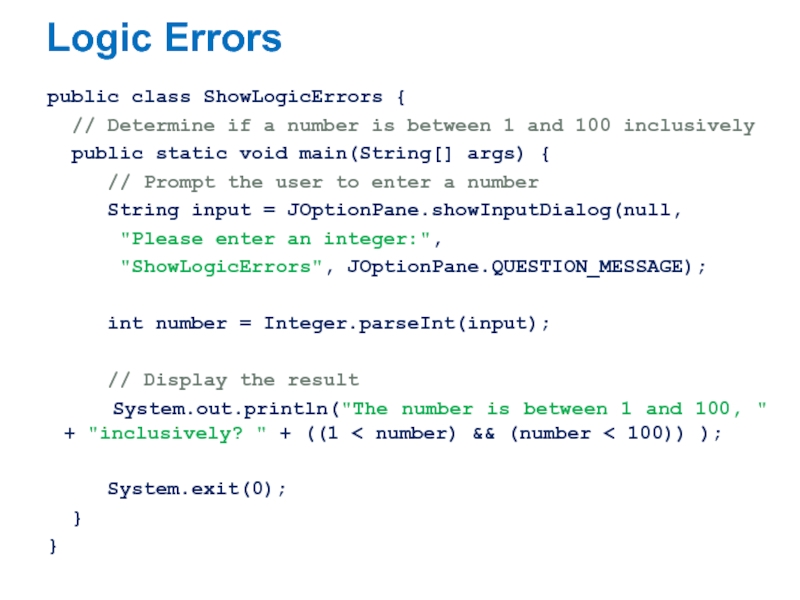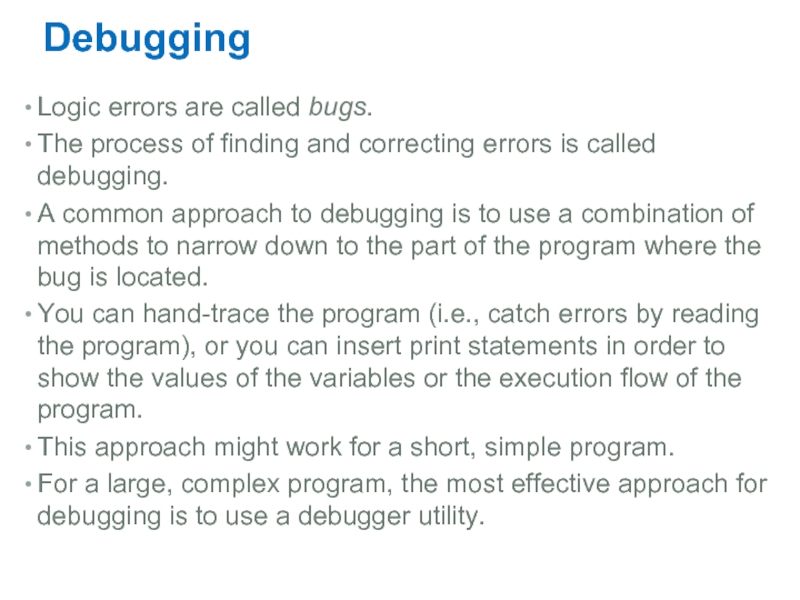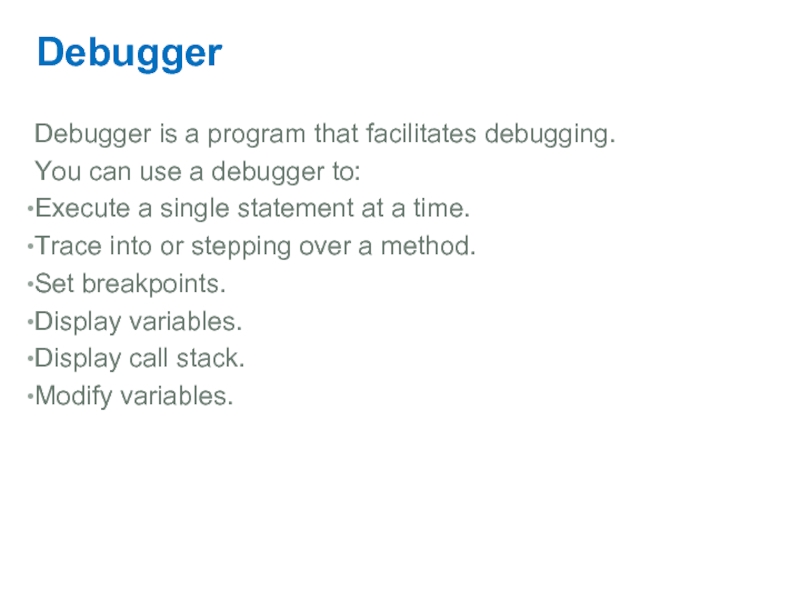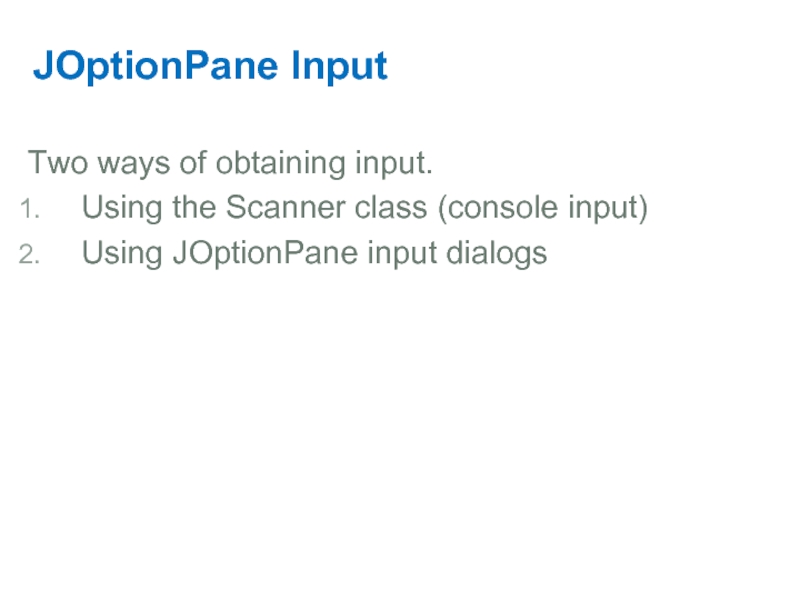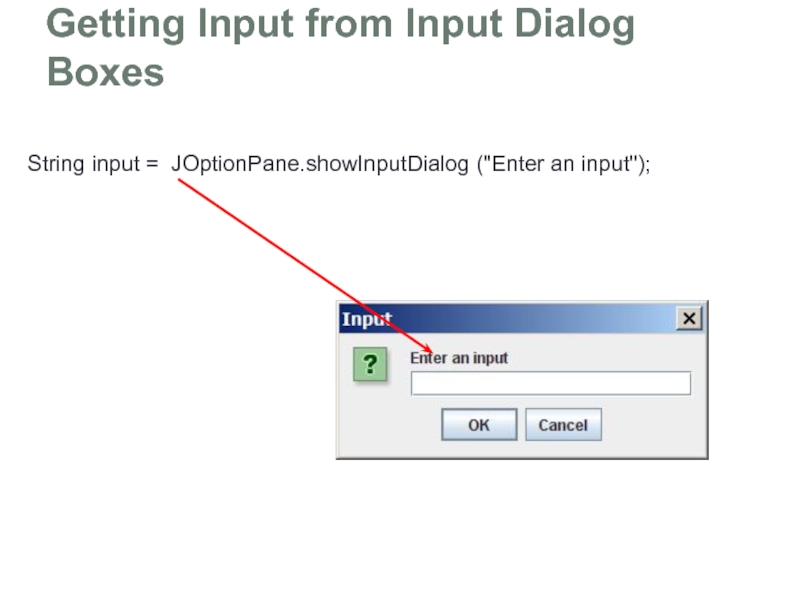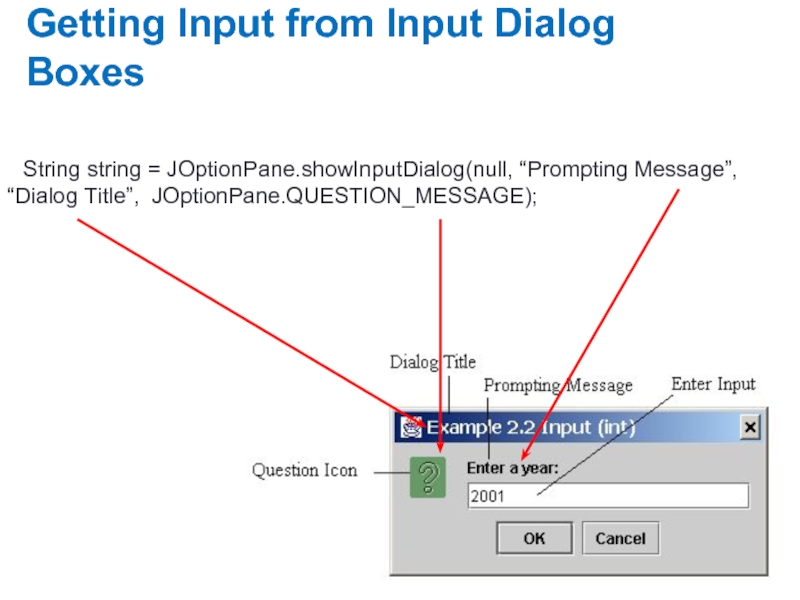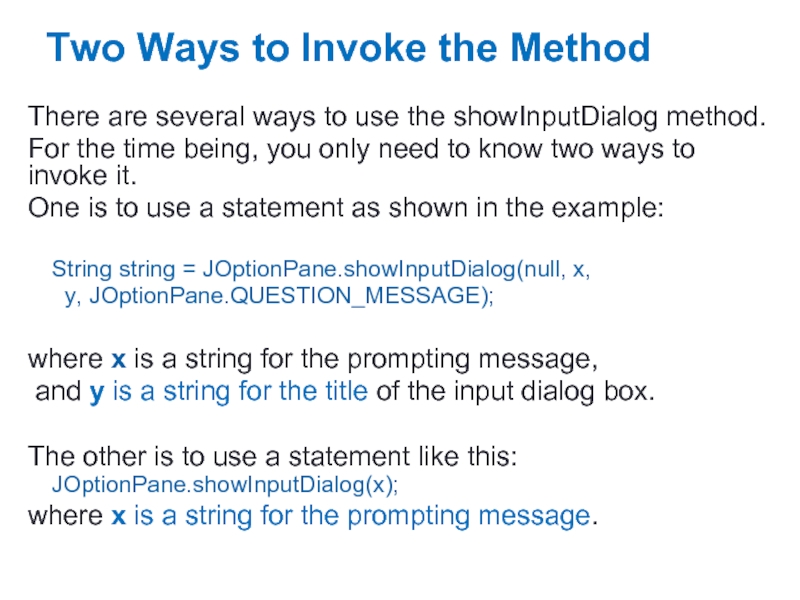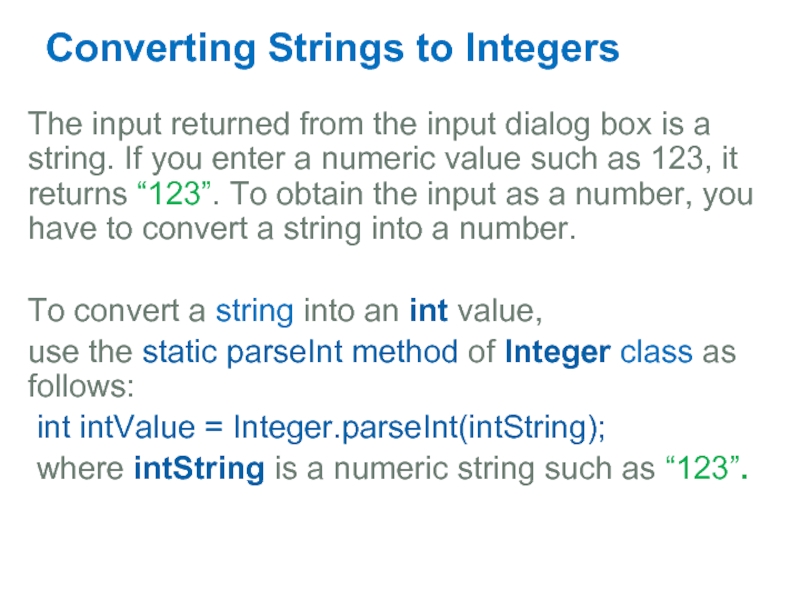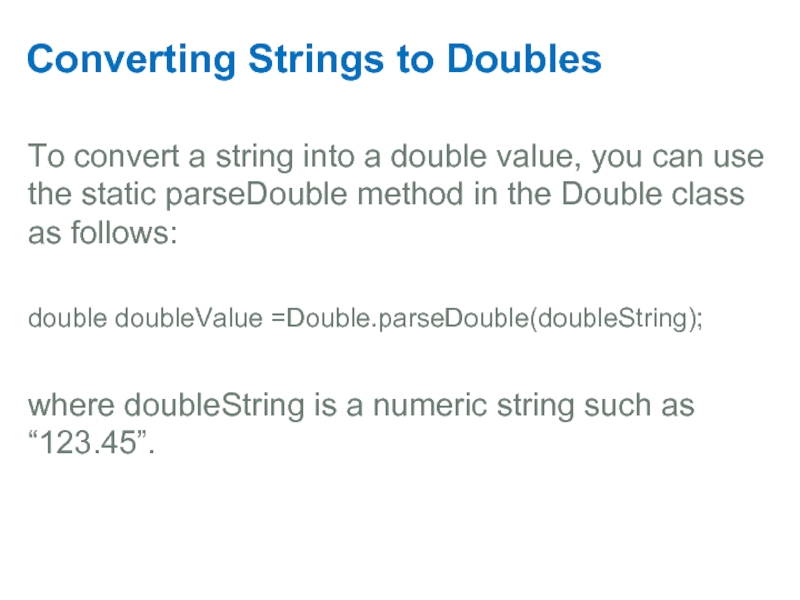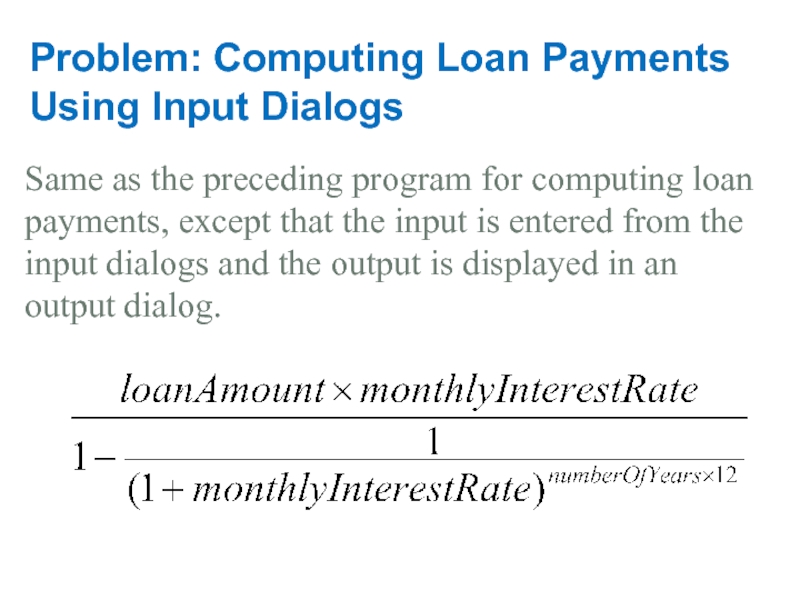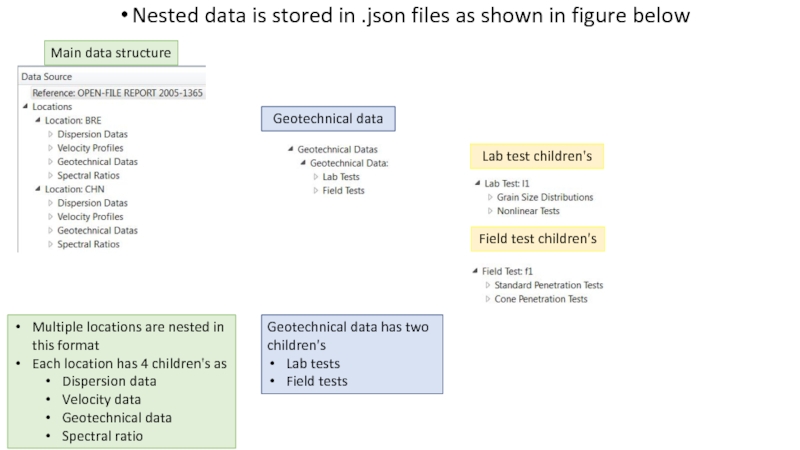- Главная
- Разное
- Дизайн
- Бизнес и предпринимательство
- Аналитика
- Образование
- Развлечения
- Красота и здоровье
- Финансы
- Государство
- Путешествия
- Спорт
- Недвижимость
- Армия
- Графика
- Культурология
- Еда и кулинария
- Лингвистика
- Английский язык
- Астрономия
- Алгебра
- Биология
- География
- Детские презентации
- Информатика
- История
- Литература
- Маркетинг
- Математика
- Медицина
- Менеджмент
- Музыка
- МХК
- Немецкий язык
- ОБЖ
- Обществознание
- Окружающий мир
- Педагогика
- Русский язык
- Технология
- Физика
- Философия
- Химия
- Шаблоны, картинки для презентаций
- Экология
- Экономика
- Юриспруденция
Elementary programming. Motivations презентация
Содержание
- 1. Elementary programming. Motivations
- 2. Motivations In the preceding lesson, you learned
- 3. Introducing Programming with an Example Computing the Area of a Circle
- 4. Trace a Program Execution public class ComputeArea
- 5. Trace a Program Execution public class ComputeArea
- 6. Trace a Program Execution public class ComputeArea
- 7. Trace a Program Execution public class ComputeArea
- 8. Trace a Program Execution public class ComputeArea
- 9. 1. Create a Scanner object
- 10. Identifiers An identifier is a sequence of
- 11. Variables // Compute the first area radius
- 12. Declaring Variables int x;
- 13. Assignment Statements x = 1;
- 14. Declaring and Initializing in One Step int x = 1; double d = 1.4;
- 15. Constants final datatype CONSTANTNAME = VALUE;
- 16. Numerical Data Types
- 17. Numeric Operators Name
- 18. Integer Division +, -, *, /, and
- 19. Remainder Operator Remainder is very useful in
- 20. NOTE Calculations involving floating-point numbers are approximated
- 21. Number Literals A literal is a constant
- 22. Integer Literals An integer literal can be
- 23. Floating-Point Literals Floating-point literals are written with
- 24. Scientific Notation Floating-point literals can also be
- 25. Arithmetic Expressions is translated to (3+4*x)/5 – 10*(y-5)*(a+b+c)/x + 9*(4/x + (9+x)/y)
- 26. How to Evaluate an Expression Though
- 27. Problem: Converting Temperatures Write a program that
- 28. Problem: Displaying Current Time Write a
- 29. Shortcut Assignment Operators Operator Example Equivalent += i += 8 i
- 30. Increment and Decrement Operators
- 31. Increment and Decrement Operators, cont.
- 32. Increment and Decrement Operators, cont. Using increment
- 33. Assignment Expressions and Assignment Statements Prior to
- 34. Numeric Type Conversion Consider the following statements:
- 35. Conversion Rules When performing a binary operation
- 36. Type Casting Implicit casting double d
- 37. Problem: Computing Loan Payments This
- 38. Character Data Type char letter = 'A';
- 39. Unicode Format Java characters use Unicode, a
- 40. Problem: Displaying Unicodes Write a program that
- 41. Escape Sequences for Special Characters Description
- 42. Appendix B: ASCII Character Set ASCII
- 43. ASCII Character Set, cont. ASCII Character
- 44. Casting between char and Numeric Types //
- 45. The String Type The char type
- 46. String Concatenation // Three strings are
- 47. Programming Style and Documentation Appropriate Comments Naming Conventions Proper Indentation and Spacing Lines Block Styles
- 48. Appropriate Comments Include a summary at the
- 49. Naming Conventions Choose meaningful and descriptive names.
- 50. Naming Conventions, cont. Class names: Capitalize
- 51. Proper Indentation and Spacing Indentation Indent two
- 52. Block Styles Use end-of-line style for braces.
- 53. Programming Errors Syntax Errors Detected by the
- 54. Syntax Errors public class ShowSyntaxErrors {
- 55. Runtime Errors public class ShowRuntimeErrors {
- 56. Logic Errors public class ShowLogicErrors {
- 57. Debugging Logic errors are called bugs. The
- 58. Debugger Debugger is a program that facilitates
- 59. JOptionPane Input Two ways of obtaining input.
- 60. Getting Input from Input Dialog Boxes
- 61. Getting Input from Input Dialog Boxes
- 62. Two Ways to Invoke the Method
- 63. Converting Strings to Integers The input returned
- 64. Converting Strings to Doubles To convert a
- 65. Problem: Computing Loan Payments Using Input Dialogs
Слайд 2Motivations
In the preceding lesson, you learned
how to create, compile, and
Starting from this chapter, you will learn how to solve practical problems programmatically. Through these problems, you will learn Java primitive data types and related subjects, such as variables, constants, data types, operators, expressions, and input and output.
Слайд 4Trace a Program Execution
public class ComputeArea {
/** Main method */
double radius;
double area;
// Assign a radius
radius = 20;
// Compute area
area = radius * radius * 3.14159;
// Display results
System.out.println("The area for the circle of radius " +
radius + " is " + area);
}
}
no value
radius
allocate memory for radius
Слайд 5Trace a Program Execution
public class ComputeArea {
/** Main method */
double radius;
double area;
// Assign a radius
radius = 20;
// Compute area
area = radius * radius * 3.14159;
// Display results
System.out.println("The area for the circle of radius " +
radius + " is " + area);
}
}
no value
radius
memory
no value
area
allocate memory for area
Слайд 6Trace a Program Execution
public class ComputeArea {
/** Main method */
double radius;
double area;
// Assign a radius
radius = 20;
// Compute area
area = radius * radius * 3.14159;
// Display results
System.out.println("The area for the circle of radius " +
radius + " is " + area);
}
}
20
radius
no value
area
assign 20 to radius
Слайд 7Trace a Program Execution
public class ComputeArea {
/** Main method */
double radius;
double area;
// Assign a radius
radius = 20;
// Compute area
area = radius * radius * 3.14159;
// Display results
System.out.println(
"The area for the circle of radius " + radius + " is " + area);
}
}
20
radius
memory
1256.636
area
compute area and assign it to variable area
Слайд 8Trace a Program Execution
public class ComputeArea {
/** Main method */
double radius;
double area;
// Assign a radius
radius = 20;
// Compute area
area = radius * radius * 3.14159;
// Display results
System.out.println("The area for the circle of radius " +
radius + " is " + area);
}
}
20
radius
memory
1256.636
area
print a message to the console
Слайд 9
1. Create a Scanner object
Scanner input = new Scanner(System.in);
2. Use
System.out.print("Enter a double value: ");
Scanner input = new Scanner(System.in);
double d = input.nextDouble();
Слайд 10Identifiers
An identifier is a sequence of characters that consist of letters,
An identifier must start with a letter, an underscore (_), or a dollar sign ($). It cannot start with a digit.
An identifier cannot be a reserved word. (See Appendix A, “Java Keywords,” for a list of reserved words).
An identifier cannot be keyword: true, false, or null.
An identifier can be of any length.
Слайд 11Variables
// Compute the first area
radius = 1.0;
area = radius * radius
System.out.println("The area is “ + area + " for radius "+radius);
// Compute the second area
radius = 2.0;
area = radius * radius * 3.14159;
System.out.println("The area is “ + area + " for radius "+radius);
Слайд 12Declaring Variables
int x; // Declare x to
// integer variable;
double radius; // Declare radius to
// be a double variable;
char a; // Declare a to be a
// character variable;
Слайд 13Assignment Statements
x = 1; // Assign 1
radius = 1.0; // Assign 1.0 to radius;
a = 'A'; // Assign 'A' to a;
Слайд 15Constants
final datatype CONSTANTNAME = VALUE;
final double PI = 3.14159;
final int SIZE = 3;
Слайд 17Numeric Operators
Name Meaning Example
+ Addition 34 + 1 35
- Subtraction 34.0 – 0.1 33.9
* Multiplication 300 * 30 9000
/ Division 1.0 / 2.0 0.5
% Remainder 20 % 3 2
Слайд 18Integer Division
+, -, *, /, and %
5 / 2 yields an
5.0 / 2 yields a double value 2.5
5 % 2 yields 1 (the remainder of the division)
Слайд 19Remainder Operator
Remainder is very useful in programming.
For example, an even
So you can use this property to determine whether a number is even or odd.
Suppose today is Saturday and you and your friends are going to meet in 10 days. What day is in 10 days? You can find that day is Tuesday using the following expression:
Слайд 20NOTE
Calculations involving floating-point numbers are approximated because these numbers are not
System.out.println(1.0 - 0.1 - 0.1 - 0.1 - 0.1 - 0.1);
displays 0.5000000000000001, not 0.5, and
System.out.println(1.0 - 0.9);
displays 0.09999999999999998, not 0.1. Integers are stored precisely. Therefore, calculations with integers yield a precise integer result.
Слайд 21Number Literals
A literal is a constant value that appears directly in
int i = 34;
long x = 1000000;
double d = 5.0;
Слайд 22Integer Literals
An integer literal can be assigned to an integer variable
An integer literal is assumed to be of the int type, whose value is between -231 (-2147483648) to 231–1 (2147483647). To denote an integer literal of the long type, append it with the letter L or l. L is preferred because l (lowercase L) can easily be confused with 1 (the digit one).
Слайд 23Floating-Point Literals
Floating-point literals are written with a decimal point. By default,
Слайд 24Scientific Notation
Floating-point literals can also be specified in scientific notation, for
Слайд 26How to Evaluate an Expression
Though Java has its own way to
Слайд 27Problem: Converting Temperatures
Write a program that converts a Fahrenheit degree to
Слайд 28Problem: Displaying Current Time
Write a program that displays current time in
The currentTimeMillis method in the System class returns the current time in milliseconds since the midnight, January 1, 1970 GMT. (1970 was the year when the Unix operating system was formally introduced.) You can use this method to obtain the current time, and then compute the current second, minute, and hour as follows.
Слайд 29Shortcut Assignment Operators
Operator Example Equivalent
+= i += 8 i = i + 8
-= f -= 8.0 f
*= i *= 8 i = i * 8
/= i /= 8 i = i / 8
%= i %= 8 i = i % 8
Слайд 32Increment and
Decrement Operators, cont.
Using increment and decrement operators makes expressions short,
Слайд 33Assignment Expressions and Assignment Statements
Prior to Java 2, all the expressions
variable op= expression; // Where op is +, -, *, /, or %
++variable;
variable++;
--variable;
variable--;
Слайд 34Numeric Type Conversion
Consider the following statements:
byte i = 100;
long k =
double d = i * 3.1 + k / 2;
Слайд 35Conversion Rules
When performing a binary operation involving two operands of different
1. If one of the operands is double, the other is converted into double.
2. Otherwise, if one of the operands is float, the other is converted into float.
3. Otherwise, if one of the operands is long, the other is converted into long.
4. Otherwise, both operands are converted into int.
Слайд 36Type Casting
Implicit casting
double d = 3; (type widening)
Explicit casting
int
int i = (int)3.9; (Fraction part is truncated)
What is wrong? int x = 5 / 2.0;
Слайд 37Problem:
Computing Loan Payments
This program lets the user enter the interest
Слайд 38Character Data Type
char letter = 'A'; (ASCII)
char
char letter = '\u0041'; (Unicode)
char numChar = '\u0034'; (Unicode)
Four hexadecimal digits.
NOTE: The increment and decrement operators can also be used on char variables to get the next or preceding Unicode character. For example, the following statements display character b.
char ch = 'a';
System.out.println(++ch);
Слайд 39Unicode Format
Java characters use Unicode, a 16-bit encoding scheme established by
Unicode \u03b1 \u03b2 \u03b3 for three Greek letters
Слайд 40Problem: Displaying Unicodes
Write a program that displays two Chinese characters and
Слайд 41Escape Sequences for Special Characters
Description Escape Sequence Unicode
Backspace
Tab \t \u0009
Linefeed \n \u000A
Carriage return \r \u000D
Backslash \\ \u005C
Single Quote \' \u0027
Double Quote \" \u0022
Слайд 42Appendix B: ASCII Character Set
ASCII Character Set is a subset of
Слайд 43ASCII Character Set, cont.
ASCII Character Set is a subset of the
Слайд 44Casting between char and Numeric Types
// Same as int i =
int i = 'a';
// Same as char c = (char)97;
char c = 97;
Слайд 45The String Type
The char type only represents one character. To
String message = "Welcome to Java";
String is actually a predefined class in the Java library just like the System class and JOptionPane class. The String type is not a primitive type. It is known as a reference type. Any Java class can be used as a reference type for a variable. Reference data types will be thoroughly discussed in Chapter 7, “Objects and Classes.” For the time being, you just need to know how to declare a String variable, how to assign a string to the variable, and how to concatenate strings.
Слайд 46String Concatenation
// Three strings are concatenated
String message = "Welcome "
// String Chapter is concatenated with number 2
String s = "Chapter" + 2; // s becomes Chapter2
// String Supplement is concatenated with character B
String s1 = "Supplement" + 'B'; // s1 becomes SupplementB
Слайд 47Programming Style and Documentation
Appropriate Comments
Naming Conventions
Proper Indentation and Spacing Lines
Block Styles
Слайд 48Appropriate Comments
Include a summary at the beginning of the program to
Include your name, class section, instructor, date, and a brief description at the beginning of the program.
Слайд 49Naming Conventions
Choose meaningful and descriptive names.
Variables and method names:
Use lowercase.
Слайд 50Naming Conventions, cont.
Class names:
Capitalize the first letter of each word
Constants:
Capitalize all letters in constants, and use underscores to connect words. For example: PI and MAX_VALUE
Слайд 51Proper Indentation and Spacing
Indentation
Indent two spaces.
Spacing
Use blank line to separate
Слайд 53Programming Errors
Syntax Errors
Detected by the compiler
Runtime Errors
Causes the program to abort
Logic
Produces incorrect result
Слайд 54Syntax Errors
public class ShowSyntaxErrors {
public static void main(String[] args) {
System.out.println(i + 4);
}
}
Слайд 55Runtime Errors
public class ShowRuntimeErrors {
public static void main(String[] args){
}
}
Слайд 56Logic Errors
public class ShowLogicErrors {
// Determine if a number is
public static void main(String[] args) {
// Prompt the user to enter a number
String input = JOptionPane.showInputDialog(null,
"Please enter an integer:",
"ShowLogicErrors", JOptionPane.QUESTION_MESSAGE);
int number = Integer.parseInt(input);
// Display the result
System.out.println("The number is between 1 and 100, " + "inclusively? " + ((1 < number) && (number < 100)) );
System.exit(0);
}
}
Слайд 57Debugging
Logic errors are called bugs.
The process of finding and correcting errors
A common approach to debugging is to use a combination of methods to narrow down to the part of the program where the bug is located.
You can hand-trace the program (i.e., catch errors by reading the program), or you can insert print statements in order to show the values of the variables or the execution flow of the program.
This approach might work for a short, simple program.
For a large, complex program, the most effective approach for debugging is to use a debugger utility.
Слайд 58Debugger
Debugger is a program that facilitates debugging.
You can use a
Execute a single statement at a time.
Trace into or stepping over a method.
Set breakpoints.
Display variables.
Display call stack.
Modify variables.
Слайд 59JOptionPane Input
Two ways of obtaining input.
Using the Scanner class (console input)
Using
Слайд 60Getting Input from Input Dialog Boxes
String input = JOptionPane.showInputDialog ("Enter
Слайд 61Getting Input from Input Dialog Boxes
String string = JOptionPane.showInputDialog(null, “Prompting
Слайд 62Two Ways to Invoke the Method
There are several ways to
For the time being, you only need to know two ways to invoke it.
One is to use a statement as shown in the example:
String string = JOptionPane.showInputDialog(null, x,
y, JOptionPane.QUESTION_MESSAGE);
where x is a string for the prompting message,
and y is a string for the title of the input dialog box.
The other is to use a statement like this:
JOptionPane.showInputDialog(x);
where x is a string for the prompting message.
Слайд 63Converting Strings to Integers
The input returned from the input dialog box
To convert a string into an int value,
use the static parseInt method of Integer class as follows:
int intValue = Integer.parseInt(intString);
where intString is a numeric string such as “123”.
Слайд 64Converting Strings to Doubles
To convert a string into a double value,
double doubleValue =Double.parseDouble(doubleString);
where doubleString is a numeric string such as “123.45”.

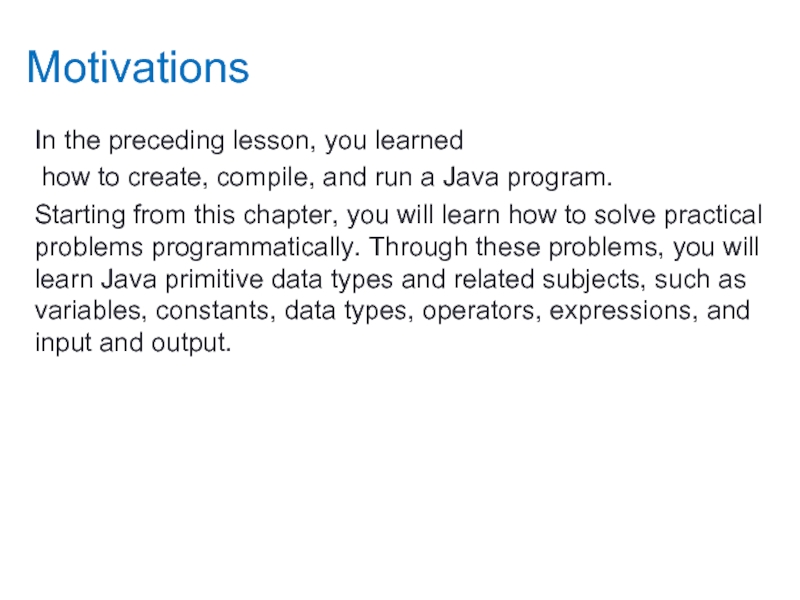
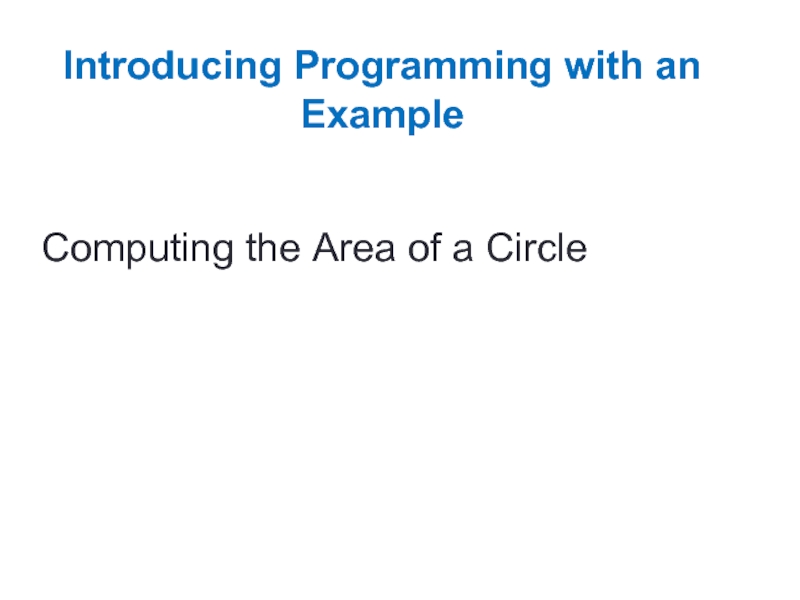
![Trace a Program Executionpublic class ComputeArea { /** Main method */ public static void main(String[]](/img/tmb/1/57498/bce4cd5c45af1098c9ddb244903830b2-800x.jpg)
![Trace a Program Executionpublic class ComputeArea { /** Main method */ public static void main(String[]](/img/tmb/1/57498/8c7999eb7733f816ad6df1822e39807a-800x.jpg)
![Trace a Program Executionpublic class ComputeArea { /** Main method */ public static void main(String[]](/img/tmb/1/57498/2aeb1ab5d48e9fe1b232675b369fbe99-800x.jpg)
![Trace a Program Executionpublic class ComputeArea { /** Main method */ public static void main(String[]](/img/tmb/1/57498/42b610a1a249f00ff289ef656d82570b-800x.jpg)
![Trace a Program Executionpublic class ComputeArea { /** Main method */ public static void main(String[]](/img/tmb/1/57498/cb254c609c3110fe713471289715f2ba-800x.jpg)
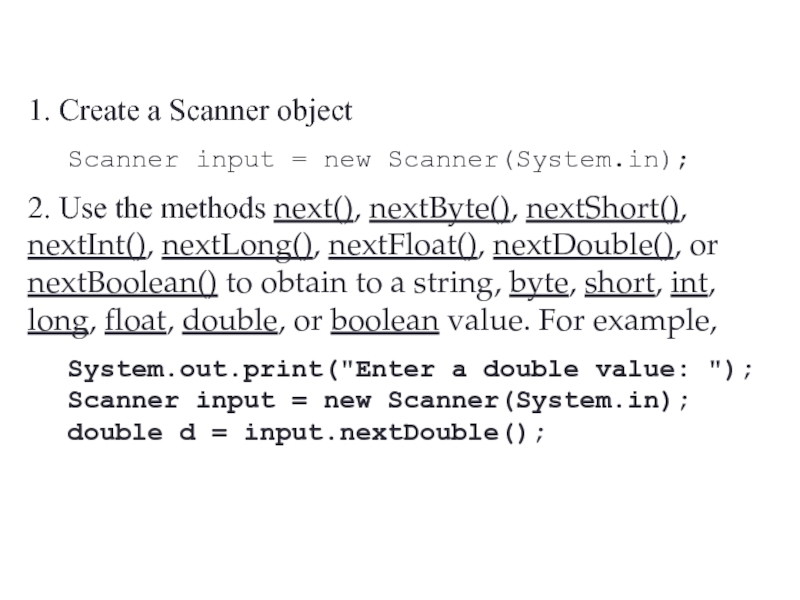
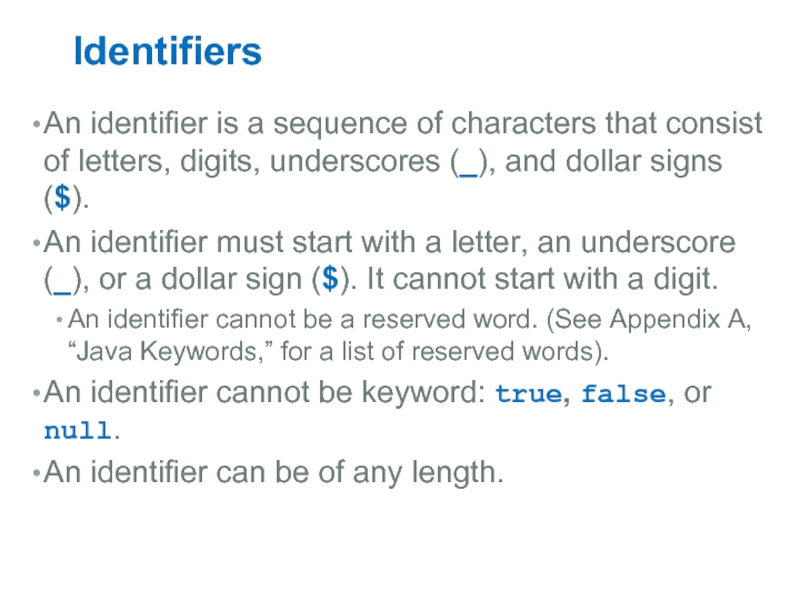
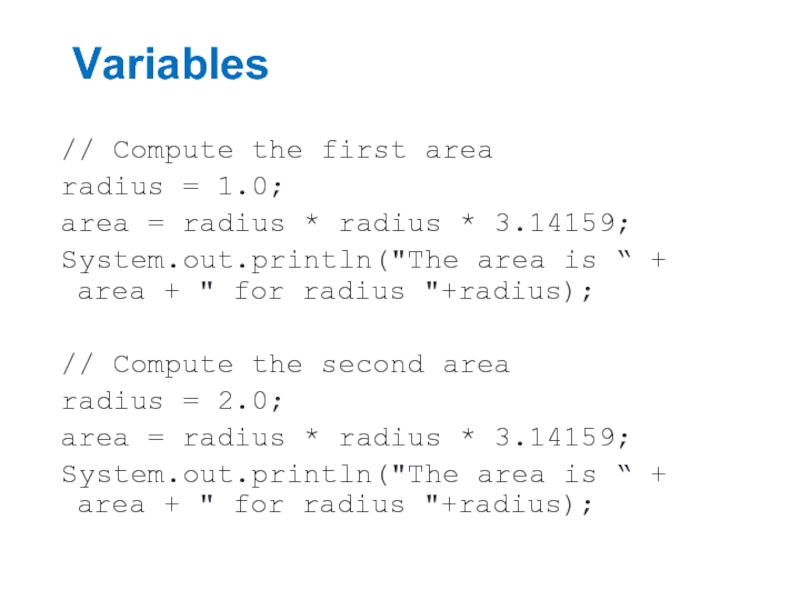
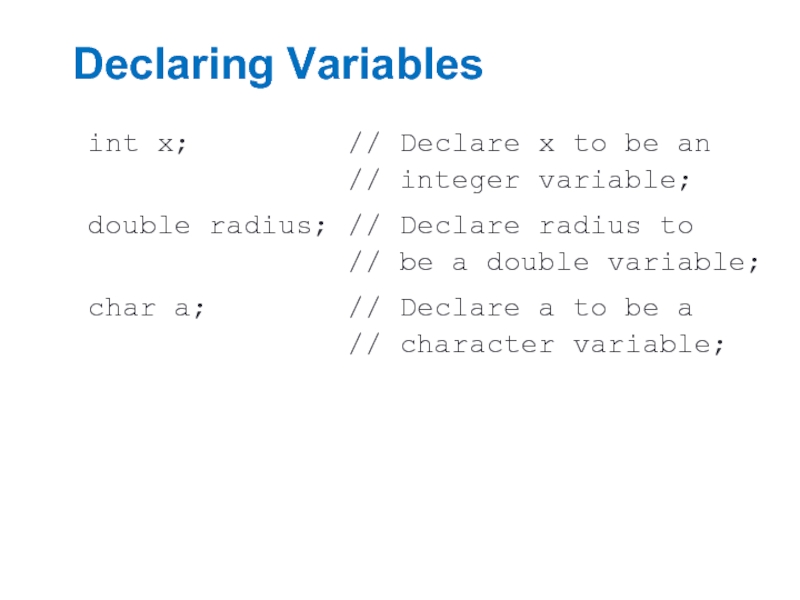
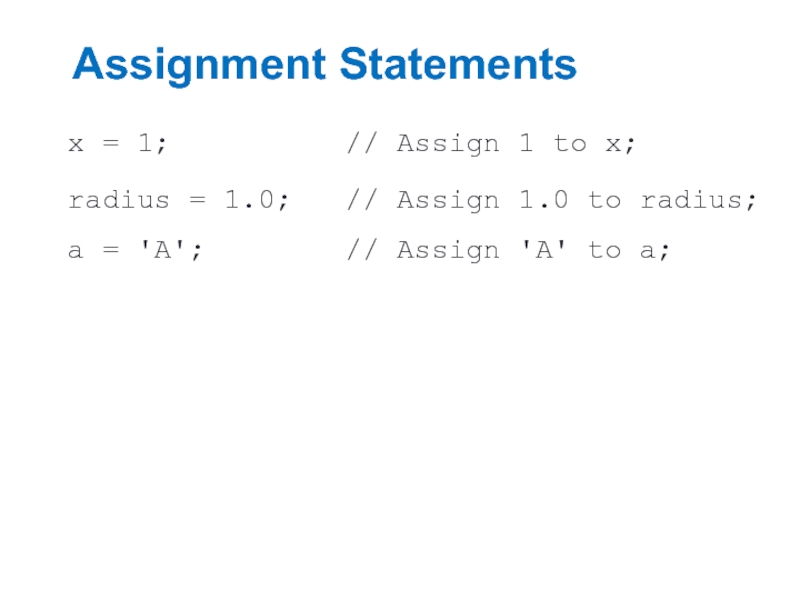
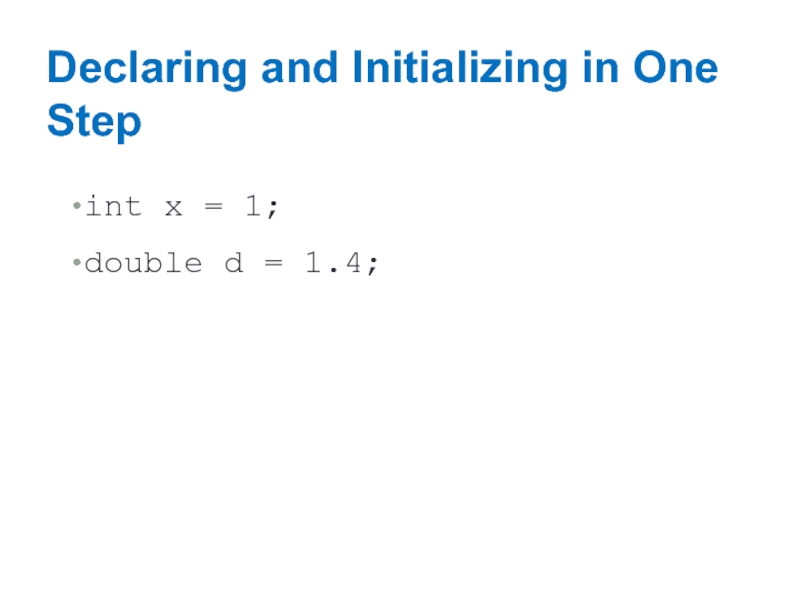
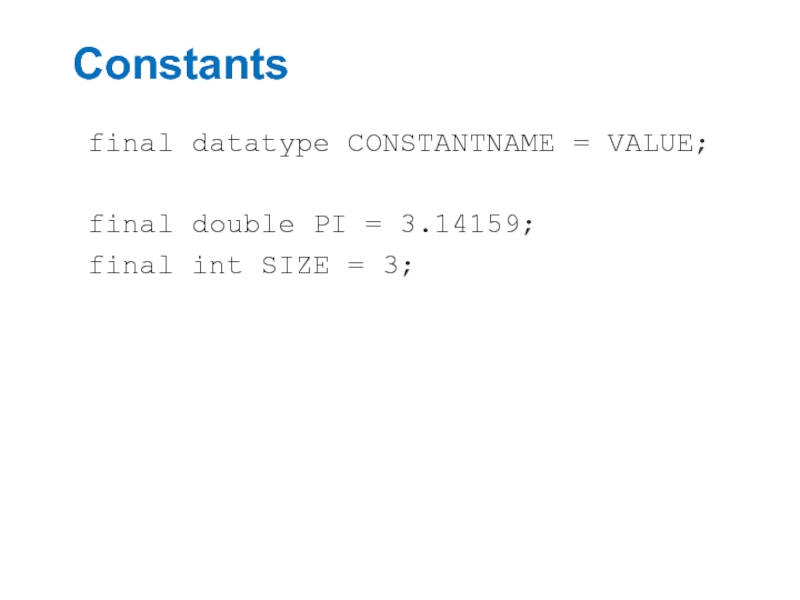
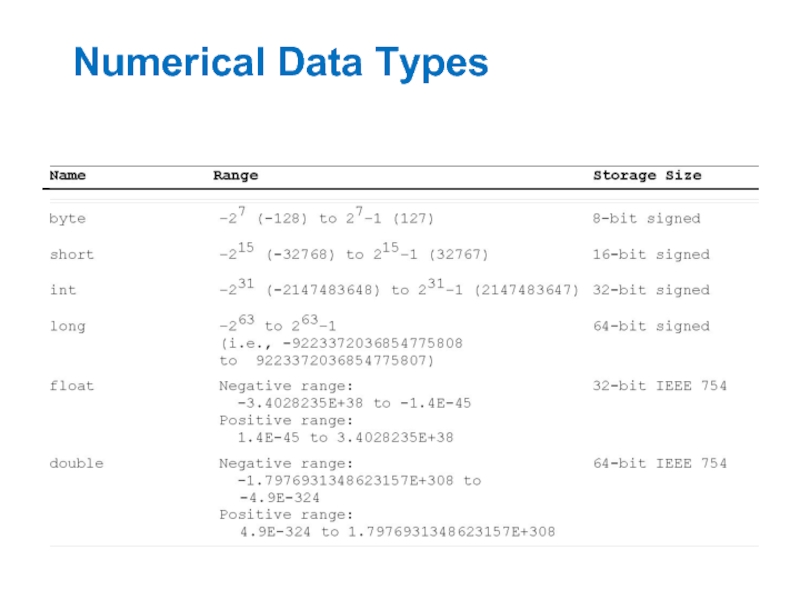
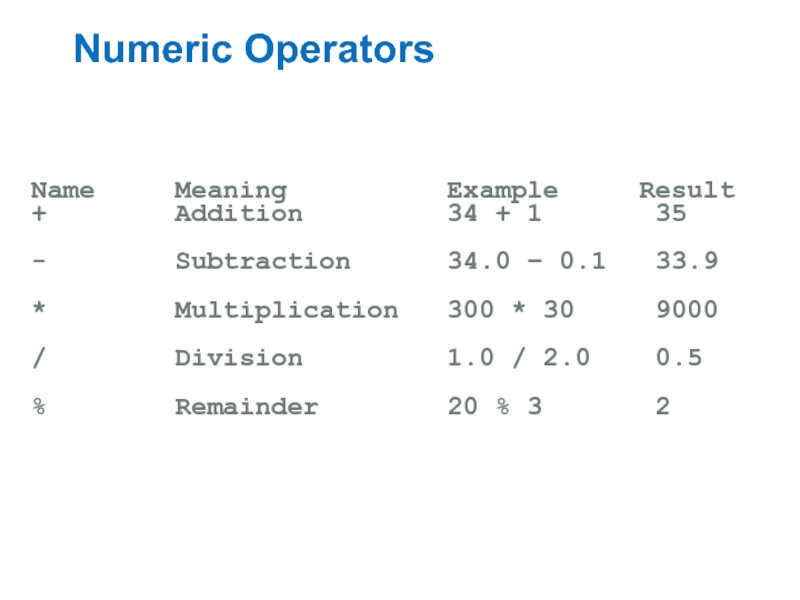
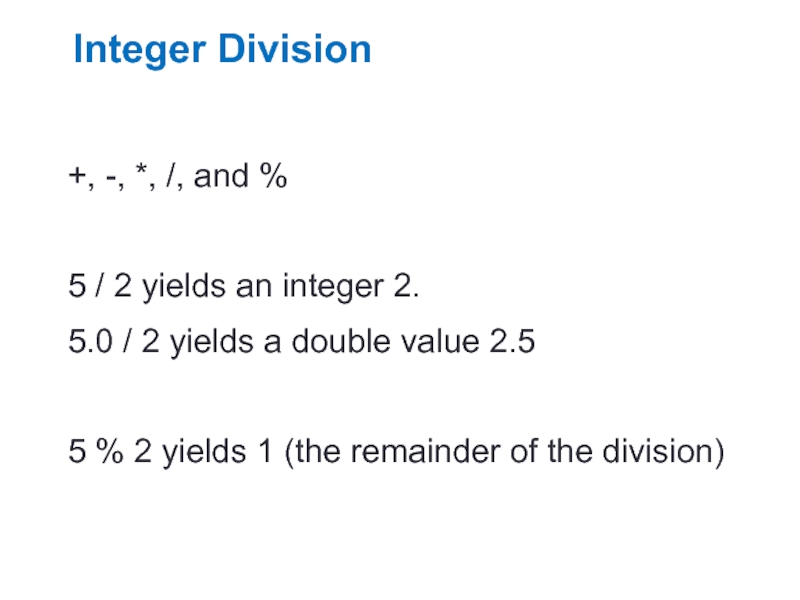
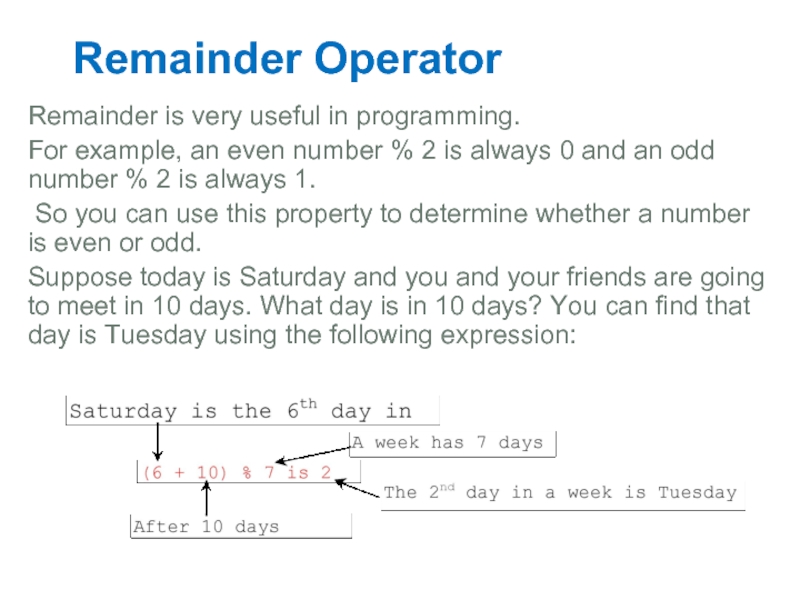
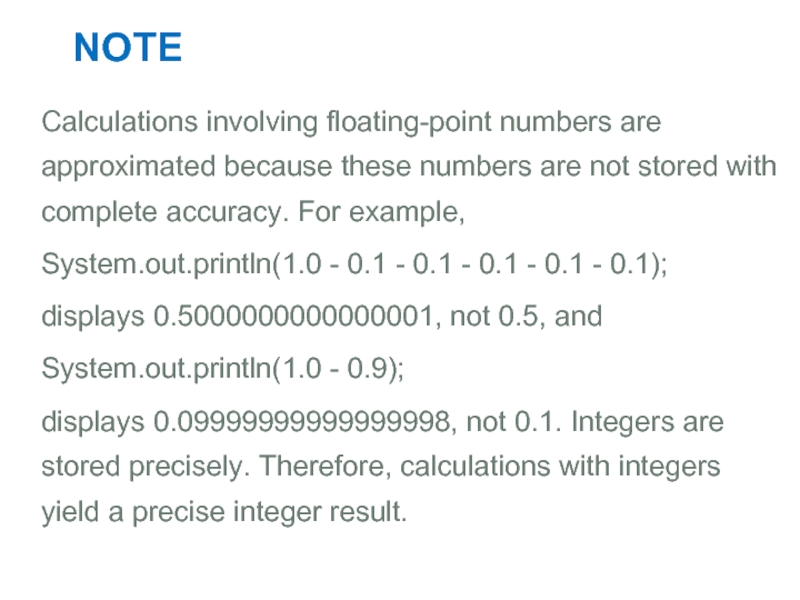
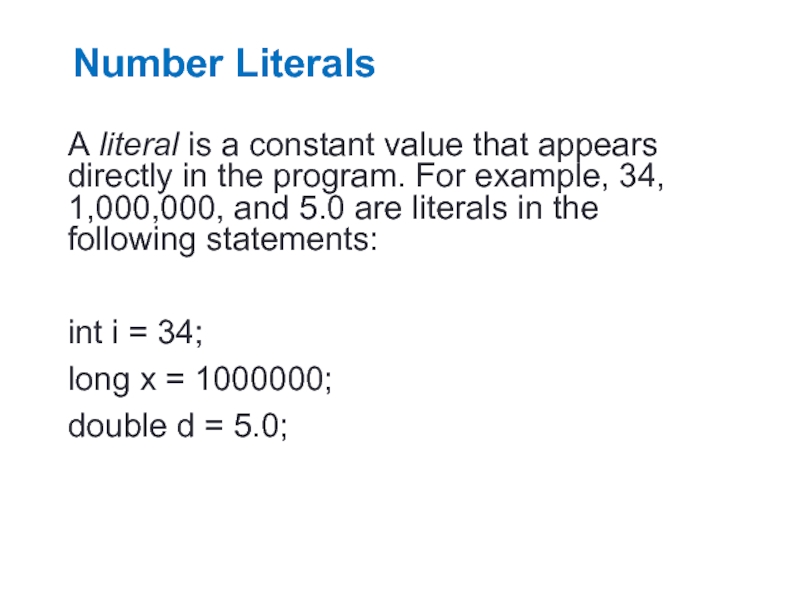
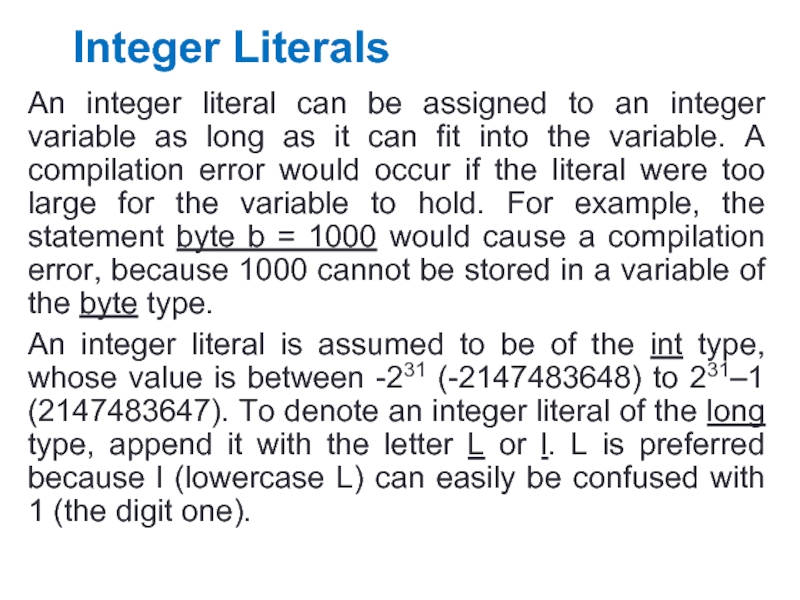
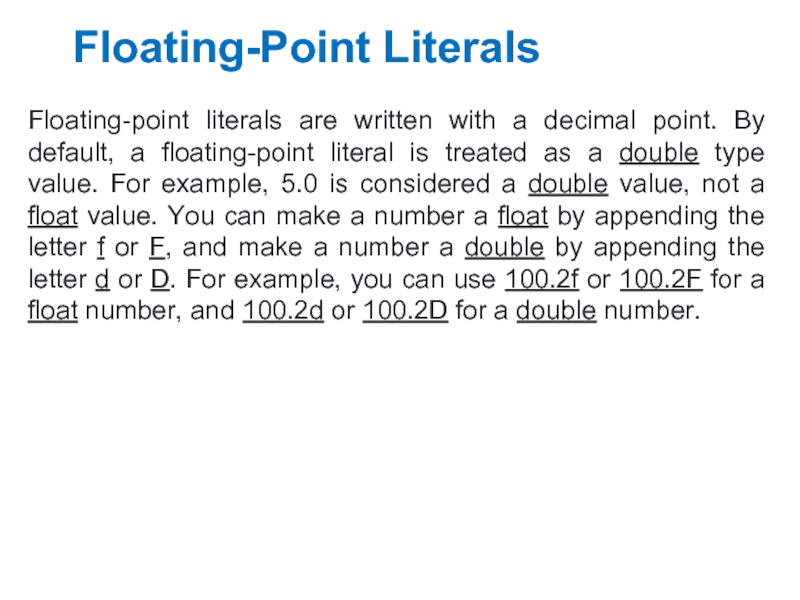

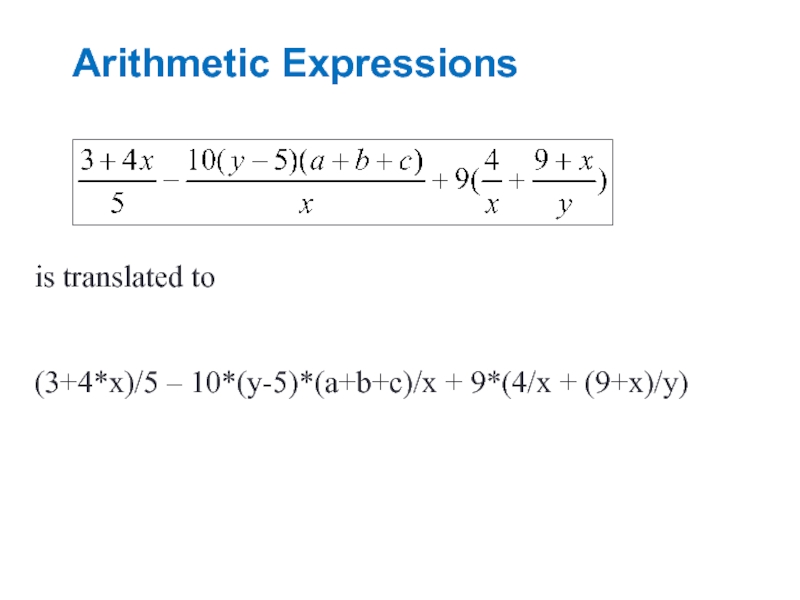
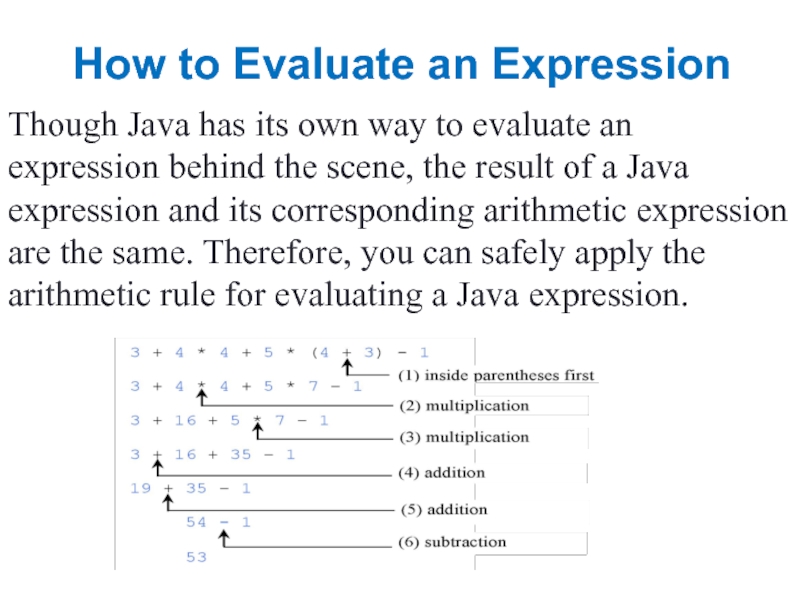
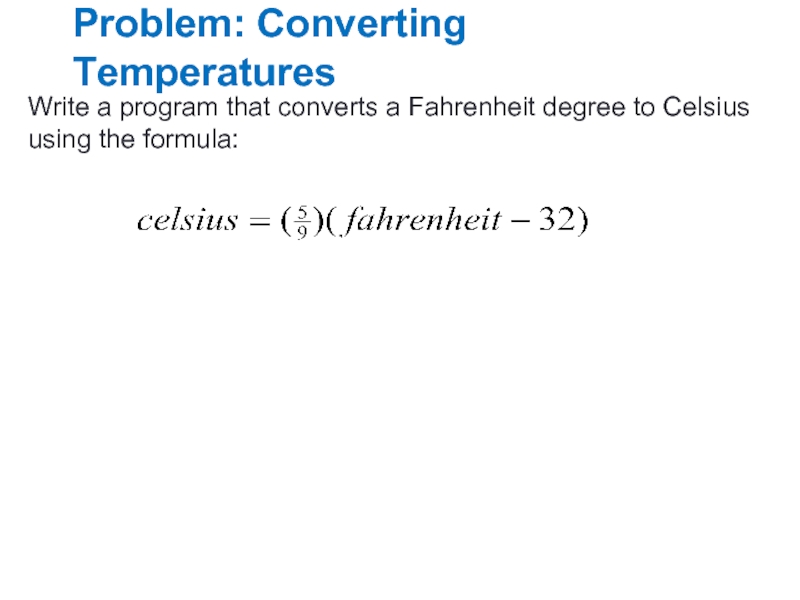
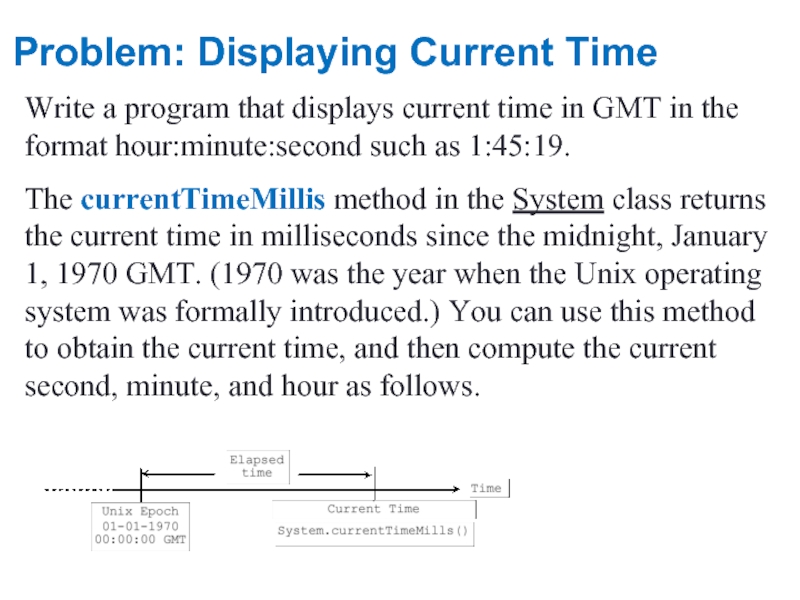
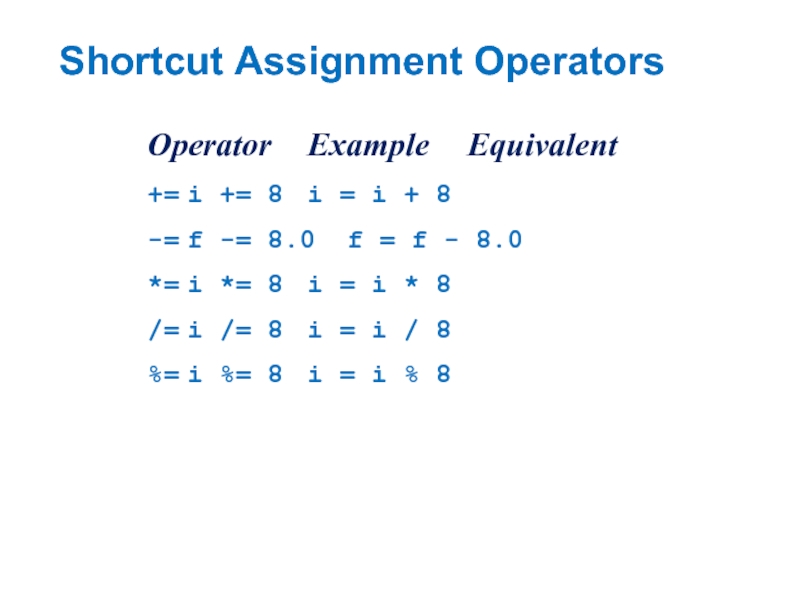
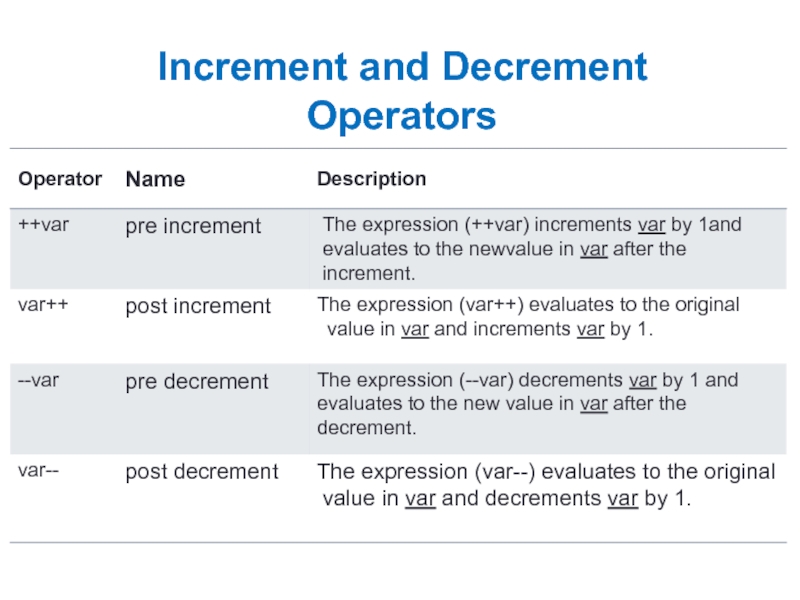
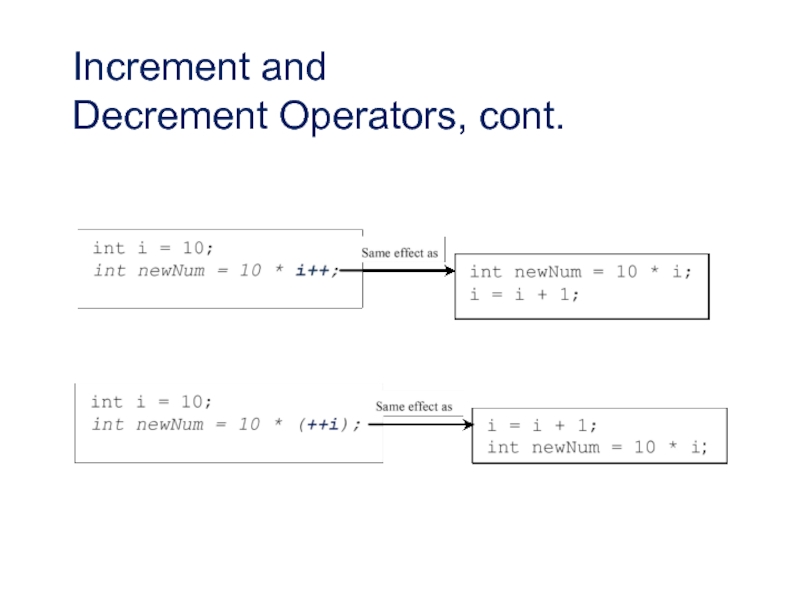
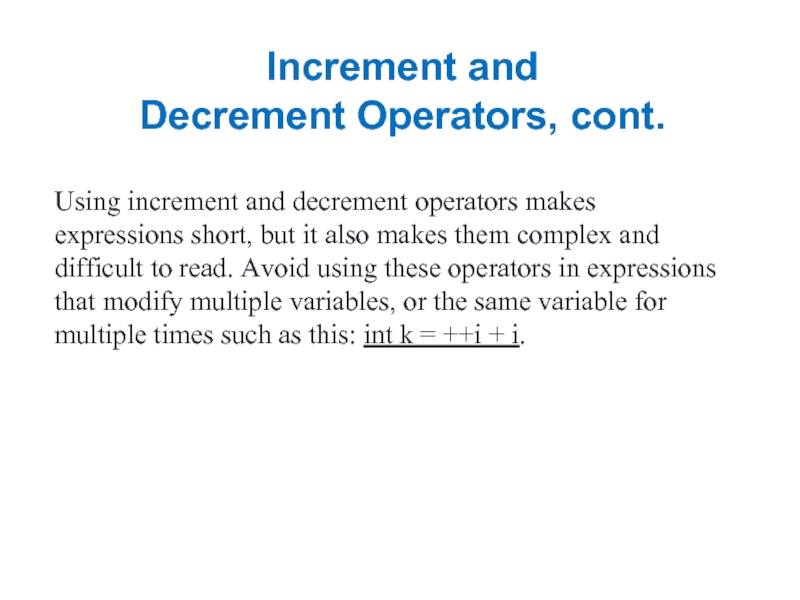
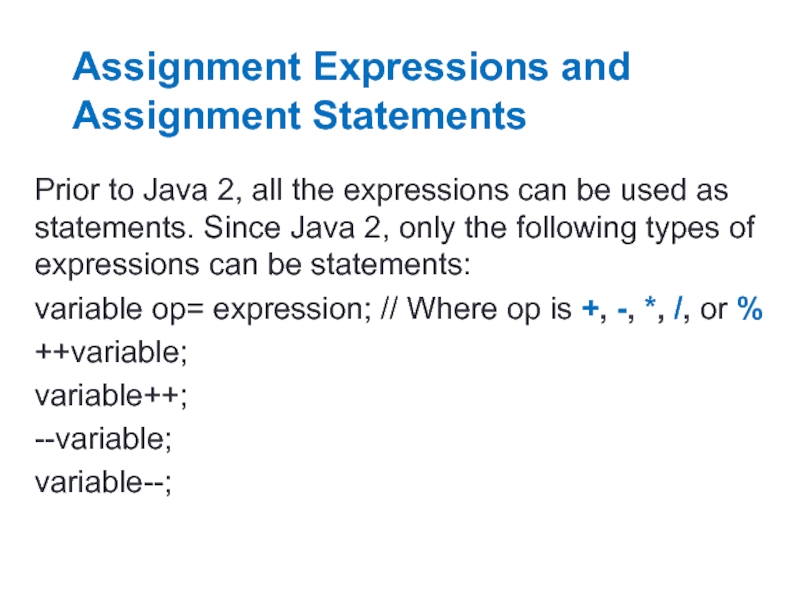
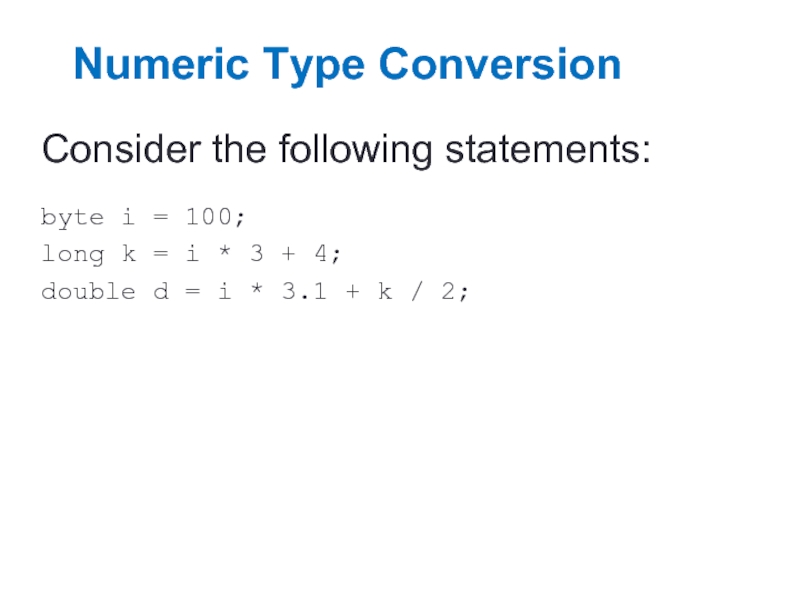
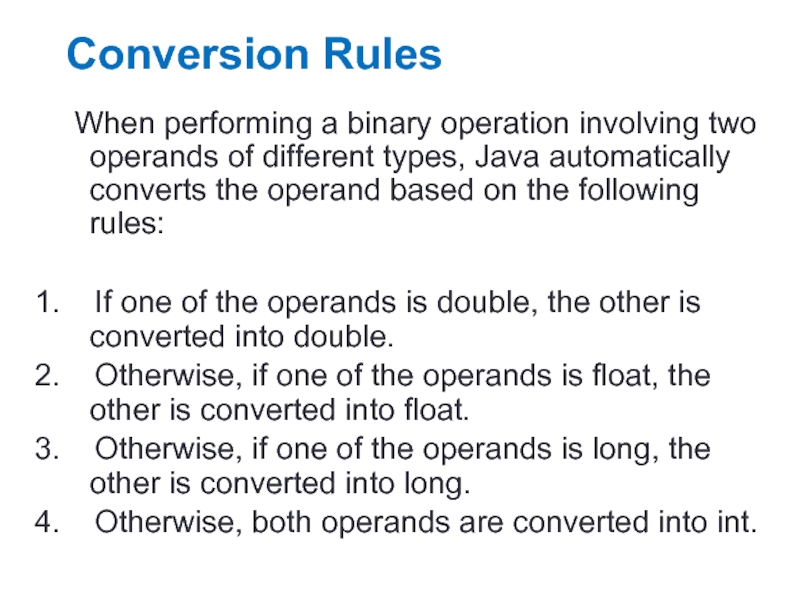
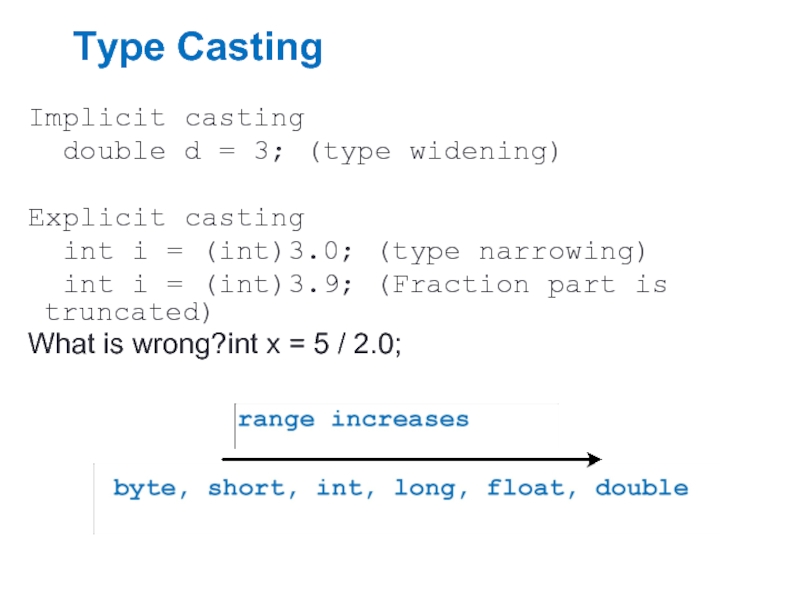

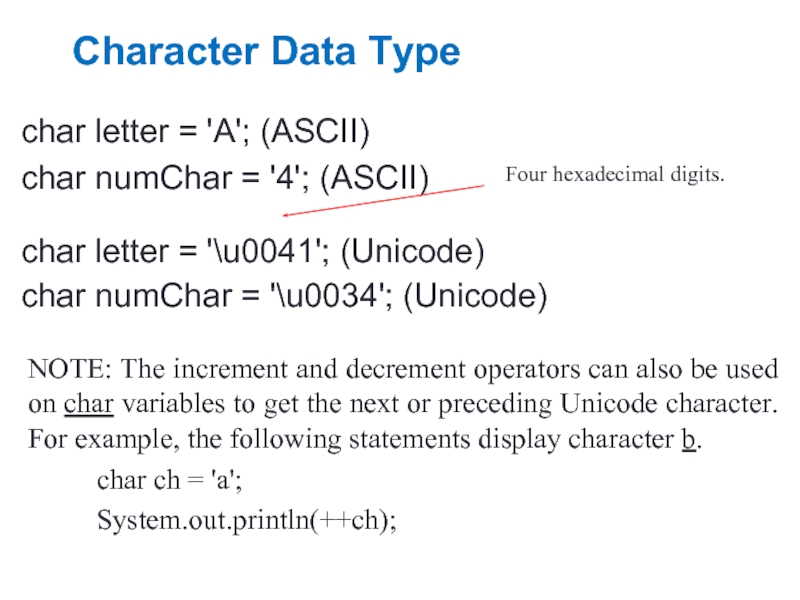
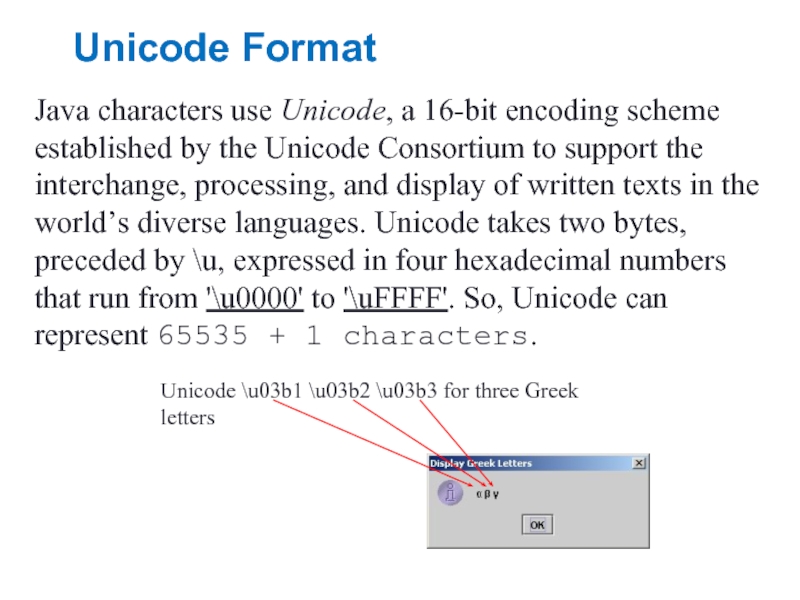

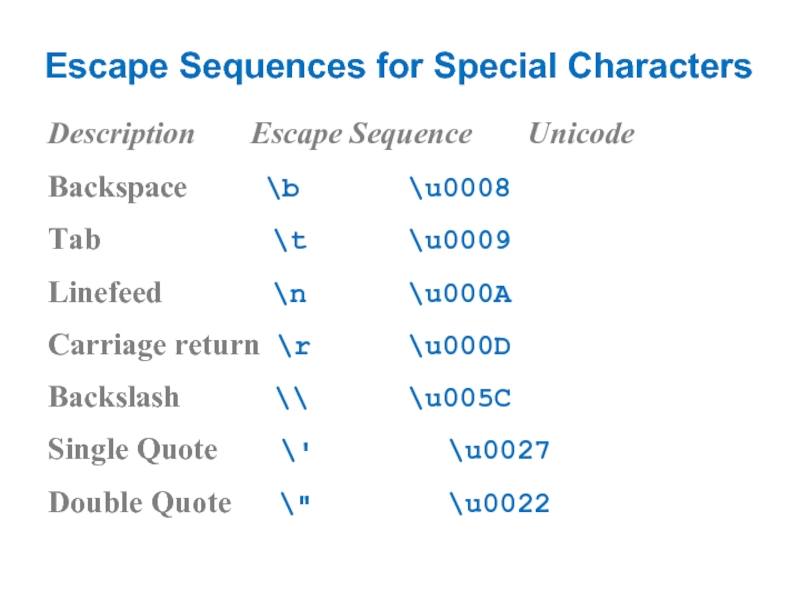
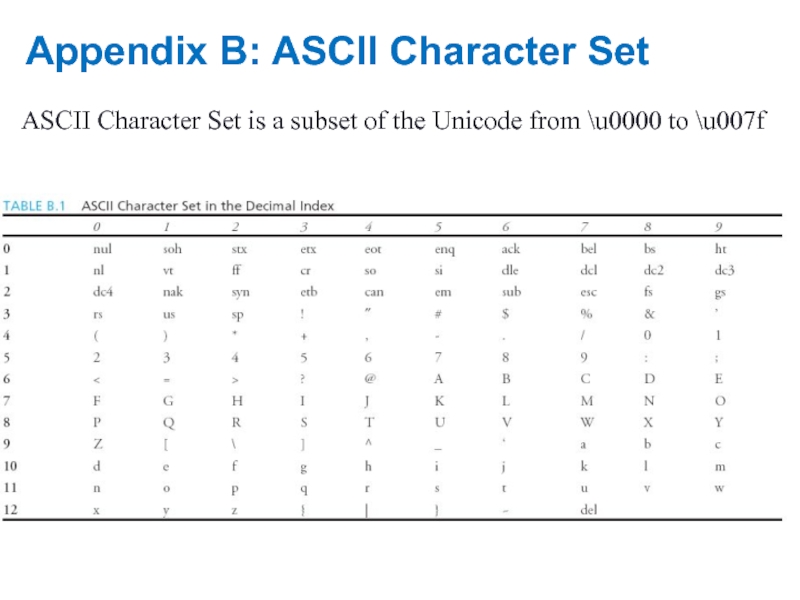
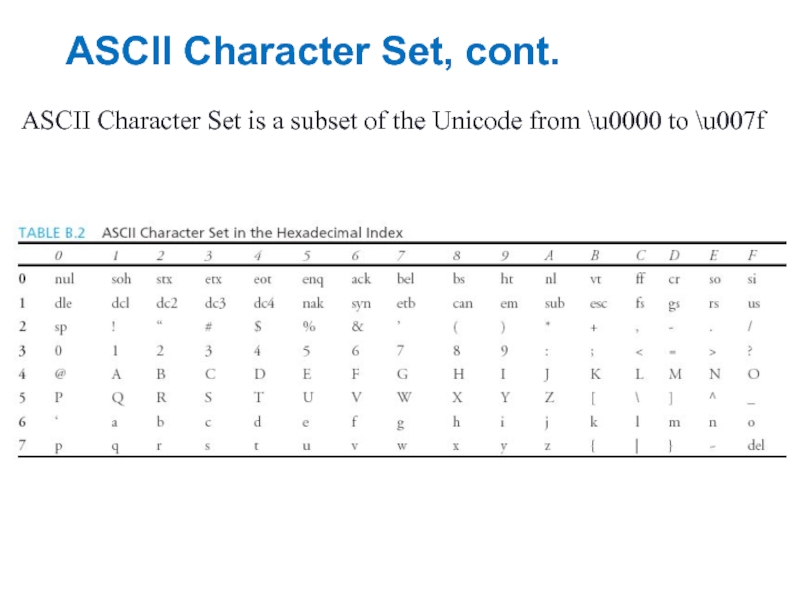
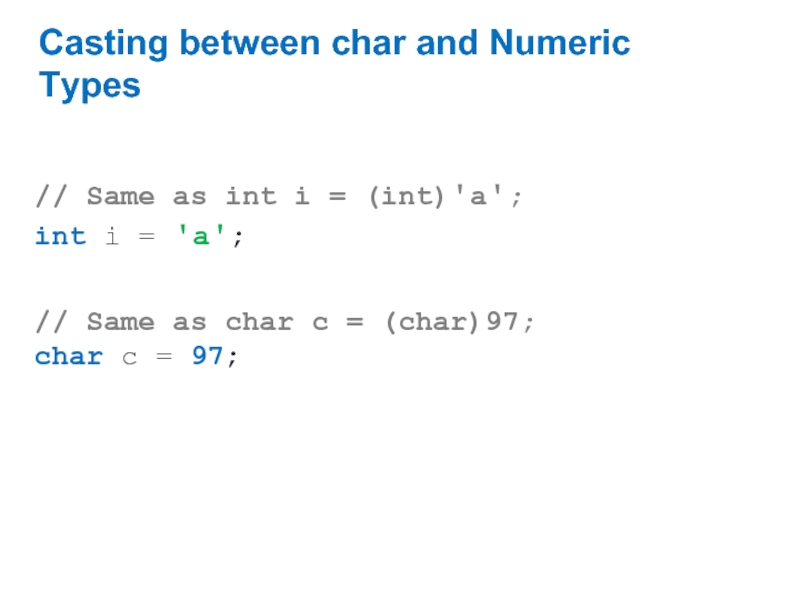
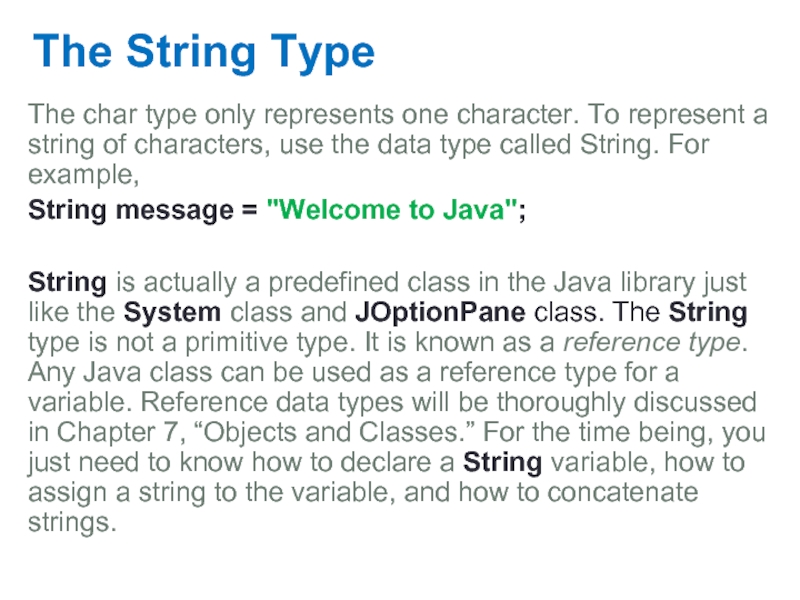
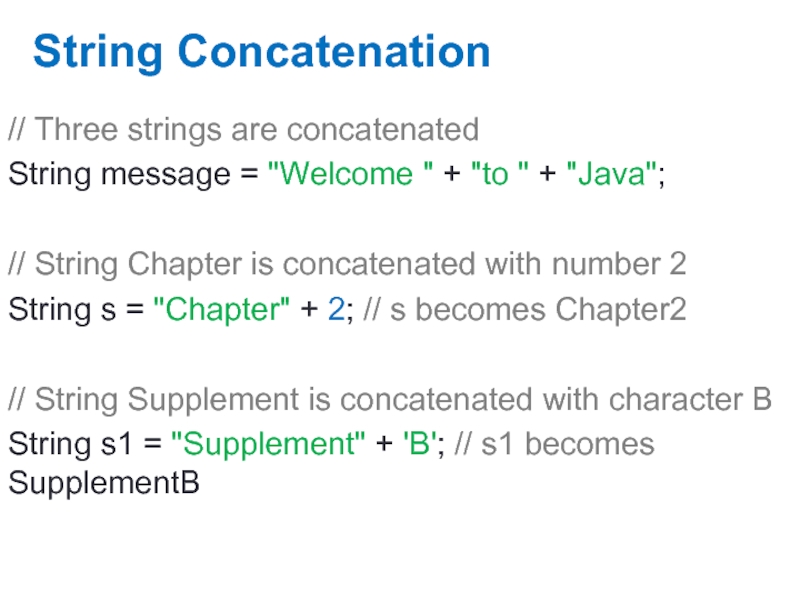
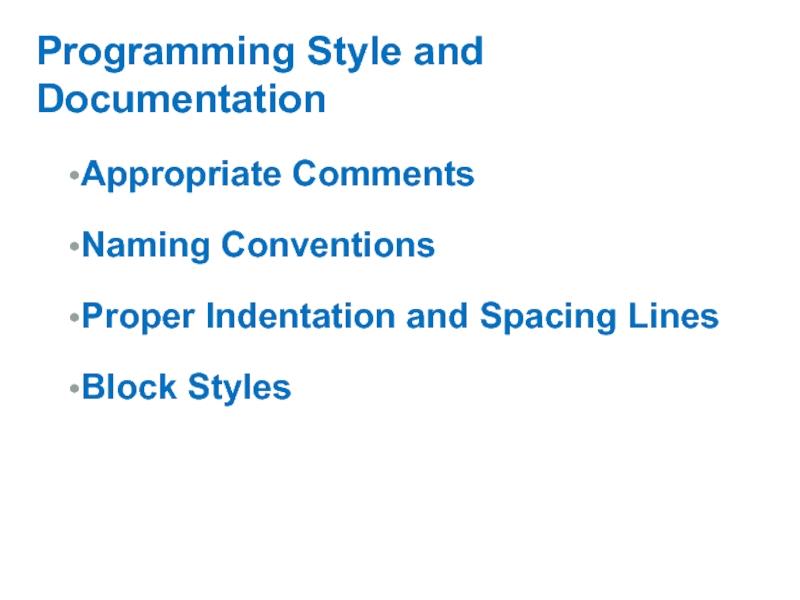
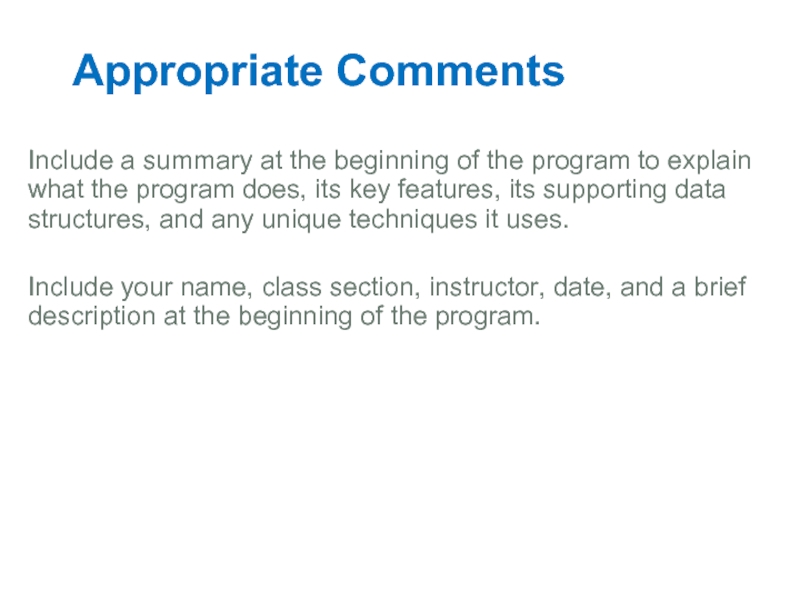
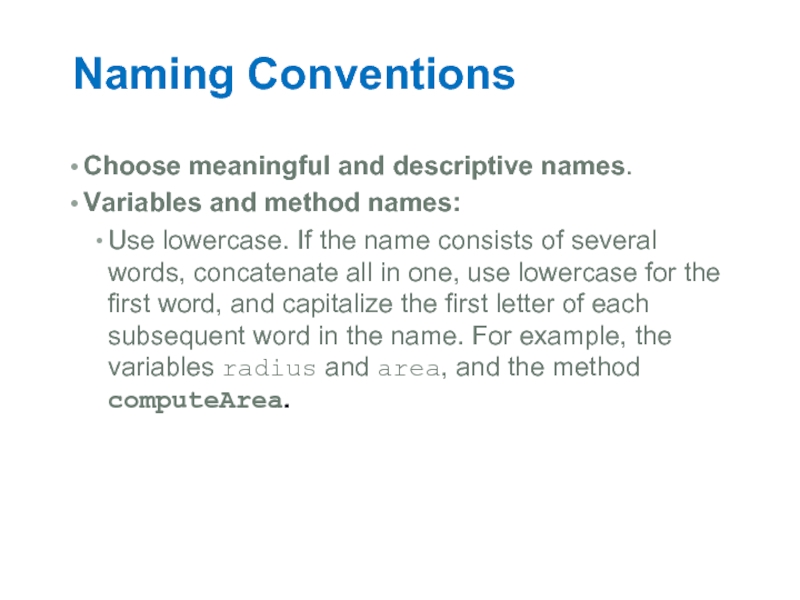
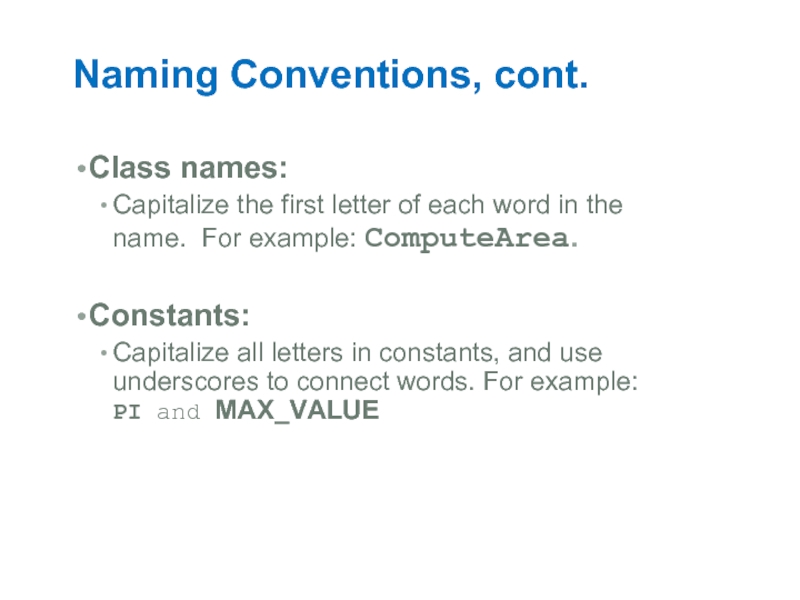
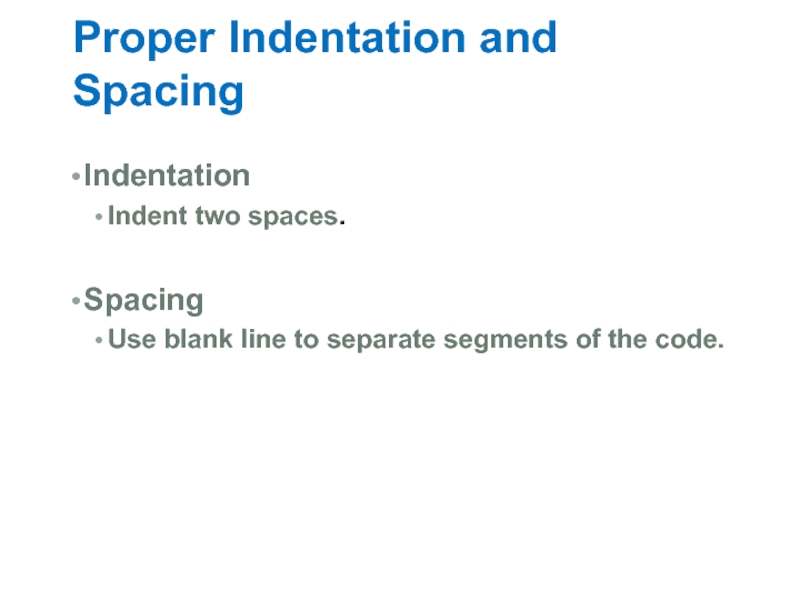
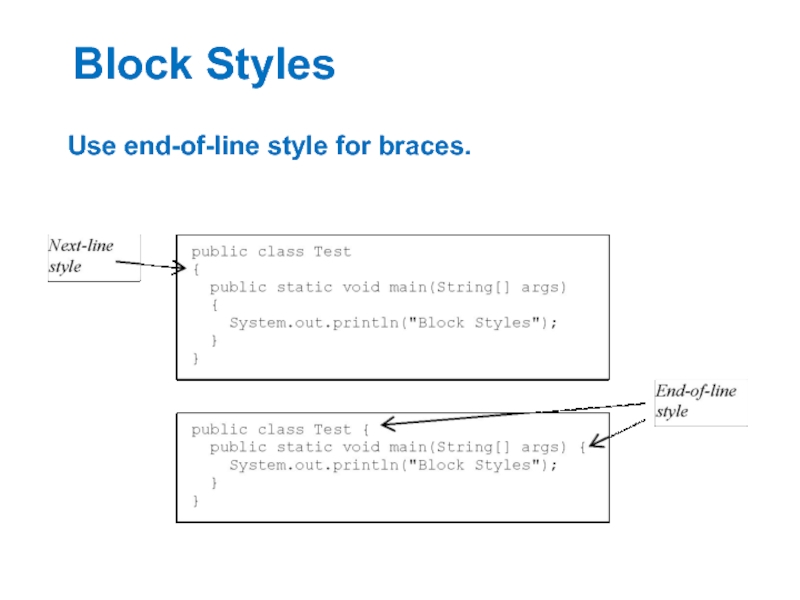
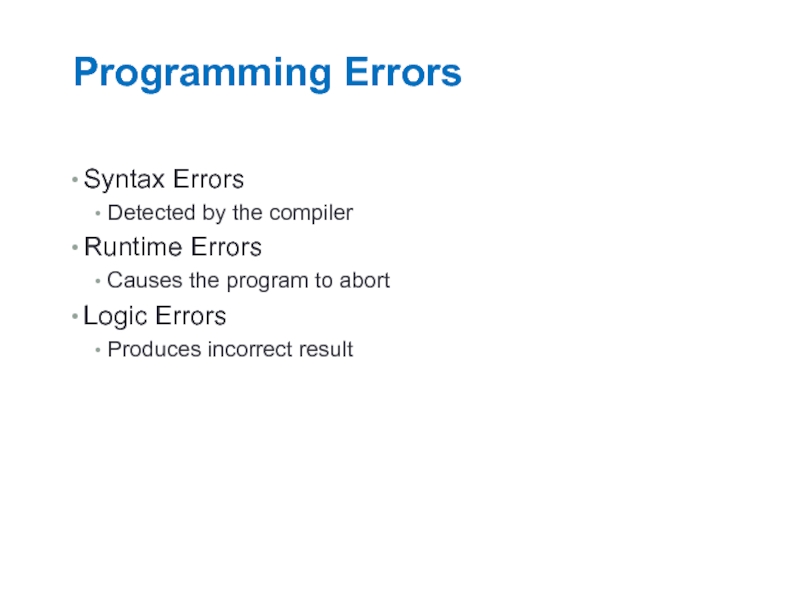
![Syntax Errorspublic class ShowSyntaxErrors { public static void main(String[] args) { i = 30; System.out.println(i](/img/tmb/1/57498/6069050fd6450db5bc38a7683489d825-800x.jpg)
![Runtime Errorspublic class ShowRuntimeErrors { public static void main(String[] args){ int i = 1 /](/img/tmb/1/57498/84de8e26911525272c064162c9e5e7b8-800x.jpg)
